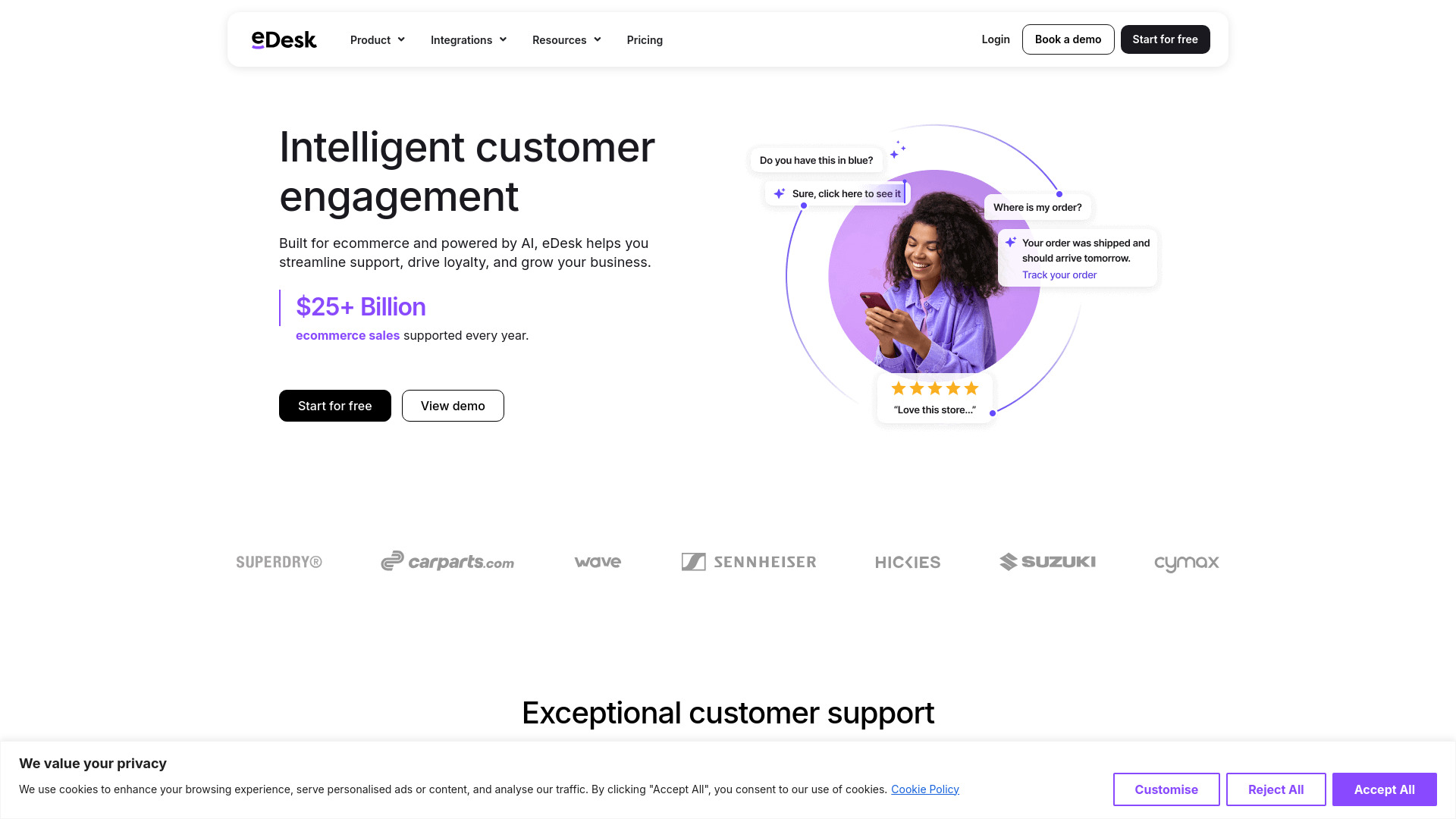- Home
- AI Customer Service
- eDesk

eDesk
Open Website-
Tool Introduction:Unify eCommerce support with AI chat, smart inbox, and channel data.
-
Inclusion Date:Oct 21, 2025
-
Social Media & Email:
Tool Information
What is eDesk AI
eDesk AI is customer service software built for eCommerce teams. It centralizes support tickets and real-time order data from every marketplace, storefront, and channel into one workspace. With AI-powered chatbots, smart inbox workflows, and deep integrations, it helps agents resolve queries faster, reduce repetitive tasks, and keep responses consistent. By aligning support with order, shipping, and refund information, eDesk AI streamlines operations, improves CX, and supports scalable growth across multi-channel retail.
eDesk AI Key Features
- Unified inbox: Consolidates tickets, customer profiles, and order details from marketplaces, D2C platforms, and communication channels into one queue.
- AI assistance: Chatbots for self-service and triage, suggested replies, intent detection, auto-tagging, sentiment cues, and AI summaries to speed up resolution.
- Order-aware support: One-click access to shipping status, payments, returns, and refunds to answer queries with full context.
- Smart automation: Rules for routing, prioritization, SLAs, tags, and macros to reduce manual work and maintain consistent workflows.
- Templates and knowledge: Reusable response templates, a searchable knowledge base, and multilingual assistance for global support.
- Analytics and QA: Reporting on volume, FRT, resolution time, SLA adherence, and team performance to guide staffing and process improvements.
- Integrations: Connects with marketplaces, online stores, email, live chat, social channels, and management/automation tools to fit existing tech stacks.
- Collaboration: Internal notes, assignments, collision detection, and role-based permissions for coordinated team workflows.
Who Should Use eDesk AI
eDesk AI suits eCommerce brands, marketplace sellers, and D2C stores that manage support across multiple channels. it's valuable for support leaders seeking a unified help desk, operations teams needing order-linked tickets, and fast-growing retailers aiming to scale service without adding headcount. Agencies and outsourced support providers can also benefit from consolidated workflows and standardized responses.
How to Use eDesk AI
- Connect sales channels and storefronts to import tickets, customers, and order data into the unified inbox.
- Link communication channels such as email, live chat, and social messaging to centralize conversations.
- Configure AI chatbots for FAQs and triage, and enable features like suggested replies and auto-tagging.
- Set up routing rules, SLAs, priorities, and macros to automate repetitive steps.
- Create templates and build a knowledge base to keep responses consistent and accurate.
- Train agents on order-aware workflows and collaboration tools like notes and assignments.
- Monitor dashboards and reports to track FRT, resolution times, and CSAT, then iterate on workflows.
- Scale by adding channels, refining automation, and adjusting staffing based on insights.
eDesk AI Industry Use Cases
A fashion retailer uses AI chatbots to handle size, shipping, and return FAQs, leaving agents to focus on exchanges and VIP care. A consumer electronics seller centralizes marketplace messages and order status, cutting first response time during product launches. A home goods D2C brand routes tickets by topic and language, using templates and AI summaries to keep replies consistent across regional teams.
eDesk AI Pricing
eDesk AI typically follows a tiered subscription model based on features and team size, with options suited to small sellers through to enterprise retailers. Plans commonly include core help desk capabilities, with advanced AI, automation, or additional integrations available on higher tiers. Free trials or demos are often offered so teams can evaluate fit before purchasing.
eDesk AI Pros and Cons
Pros:
- Single workspace for tickets and order data reduces context switching.
- AI suggestions and chatbots accelerate responses and deflect repetitive queries.
- Automation and SLAs standardize workflows and improve consistency.
- Order-aware context improves accuracy on shipping, refunds, and returns.
- Actionable analytics support staffing and process decisions.
Cons:
- Requires initial setup and integration effort across channels and stores.
- Automation and AI features may need tuning to match brand voice and policies.
- Costs can scale with seats, volume, or advanced feature usage.
eDesk AI FAQs
-
Does eDesk AI support multiple marketplaces and stores?
Yes. It unifies messages and order data across marketplaces, D2C storefronts, and communication channels into one inbox.
-
Can it automate replies without losing quality?
AI chatbots and suggested replies handle common questions and draft responses. Human review, templates, and policies help maintain brand tone and accuracy.
-
Do I need coding skills to set it up?
No. Most connections are configured through built-in connectors and rules. An API may be available for custom workflows if needed.
-
How does eDesk AI handle data security?
It follows standard security practices and offers role-based access controls. For specific compliance details, review official documentation before deployment.


